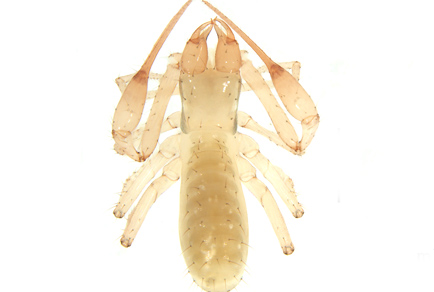Abstract
The genus of Lagynochthonius from China was reviewed. Nine new hypogean species were described: Lagynochthonius apexus sp. nov. (♂♀), L. infirmus sp. nov. (♂♀), L. longquanensis sp. nov. (♀) and L. zhakouensis sp. nov. (♂♀) from Sichuan, L. baiguensis sp. nov. (♂♀), L. guangyangensis sp. nov. (♂♀), L. jingshengensis sp. nov. (♂♀) and L. zhaoae sp. nov. (♀) from Guangxi, L. galeatus sp. nov. (♀) from Guizhou. The male L. guanniuensis Hou, Feng & Zhang, 2023, L. maanensis Hou, Feng & Zhang, 2023 and L. xiaoensis Hou, Feng & Zhang, 2023 from Guizhou are reported for the first time. The species key and a geographical distribution map of Lagynochthonius species from China are provided.
References
- Beier, M. (1951) Die Pseudoscorpione Indochinas. Mémoires du Muséum National d’Histoire Naturelle, Paris, Nouvelle série, 1, 47–123.
- Beier, M. (1955) A second collection of Pseudoscorpionidea from Malaya. Bulletin of the Raffles Museum, 25, 38–46.
- Beier, M. (1967) Pseudoscorpione vom kontinentalen Südost-Asien. Pacific Insects, 9, 341–369.
- Benavides, L.R., Cosgrove, J.G., Harvey, M.S. & Giribet, G. (2019) Phylogenomic interrogation resolves the backbone of the Pseudoscorpiones tree of life. Molecular Phylogenetics and Evolution, 139, 1–14. https://doi.org/10.1016/j.ympev.2019.05.023
- Chamberlin, J.C. (1931) The arachnid order Chelonethida. Stanford University Publications, University Series. Biological Sciences, 7, 1–284.
- Chamberlin, J.C. (1962) New and little-known false scorpions, principally from caves, belonging to the families Chthoniidae and Neobisiidae (Arachnida, Chelonethida). Bulletin of the American Museum of Natural History, 123, 303–352.
- Culver, D.C. & Pipan, T. (2014) Shallow subterranean habitats: ecology, evolution, and conservation. Oxford University, Oxford, 288 pp. https://doi.org/10.1093/acprof:oso/9780199646173.001.0001
- Dai, B., Peng, T., Zhang, X.B., Mo, X.M., & Wang, S.J. (2023) Major types and formation mechanism of karst hill in plateau and discussion on karst landform zoning in Guizhou, China [J]. Mountain Research, 41 (2), 155–168.
- Edward, K.L. & Harvey, M.S. (2008) Short-range endemism in hypogean environments: the pseudoscorpion genera Tyrannochthonius and Lagynochthonius (Pseudoscorpiones: Chthoniidae) in the semiarid zone of Western Australia. Invertebrate Systematics, 22, 259–293. https://doi.org/10.1071/IS07025
- Harvey, M.S. (1989) Two new cavernicolous chthoniids from Australia, with notes on the generic placement of the southwestern Pacific species attributed to the genera Paraliochthonius Beier and Morikawia Chamberlin (Pseudoscorpionida: Chthoniidae). Bulletin of the British Arachnological Society, 8, 21–29.
- Harvey, M.S. (1992) The phylogeny and classification of the Pseudoscorpionida (Chelicerata: Arachnida). Invertebrate Taxonomy, 6, 1373–1435. https://doi.org/10.1071/IT9921373
- Hou, Y.M., Feng, Z.G. & Zhang, F. (2023a) New cave-dwelling pseudoscorpions of the genus Lagynochthonius (Pseudoscorpiones, Chthoniidae) from Guizhou in China. Zootaxa, 5309 (1), 1–64. https://doi.org/10.11646/zootaxa.5309.1.1
- Hou, Y.M., Feng, Z.G. & Zhang, F. (2023b) Three new species of cave-adapted pseudoscorpions (Pseudoscorpiones, Chthoniidae) from eastern Yunnan, China. ZooKeys, 1153, 73–95. https://doi.org/10.3897/zookeys.1153.99537
- Hou, Y.M., Gao, Z.Z. & Zhang, F. (2022a) Two new species of cave-adapted pseudoscorpions (Pseudoscorpiones, Chthoniidae) from Yunnan, China. ZooKeys, 1097, 65–83. https://doi.org/10.3897/zookeys.1097.82527
- Hou, Y.M., Gao, Z.Z. & Zhang, F. (2022b) Diversity of cave-dwelling pseudoscorpions from eastern Yunnan in China, with the description of eleven new species of the genus Lagynochthonius (Pseudoscorpiones, Chthoniidae). Zootaxa, 5198 (1), 1–65. https://doi.org/10.11646/zootaxa.5198.1.1
- Hu, J.F. & Zhang, F. (2012a) New species of the genus Lagynochthonius Beier (Pseudoscorpiones: Chthoniidae) from Hainan Island, China. Entomological News, 122, 223–232. https://doi.org/10.3157/021.122.0303
- Hu, J.F. & Zhang, F. (2012b) A new species of Lagynochthonius (Pseudoscorpions: Chthoniidae) from Yunnan Province, China. Acta Arachnologica, 61 (1), 21–25. https://doi.org/10.2476/asjaa.61.21
- Juberthie, C., Delay, B. & Bouillon, M. (1980) Extension du milieu souterrain en zone non calcaire: description d’un nouveau milieu et de son peuplement par les Coléoptères troglobies. Mémoires de biospéologie, 7, 719–752.
- Judson, M.L.I. (2007) A new and endangered species of the pseudoscorpion genus Lagynochthonius from a cave in Vietnam, with notes on chelal morphology and the composition of the Tyrannochthoniini (Arachnida, Chelonethi, Chthoniidae). Zootaxa, 1627 (1), 53–68. https://doi.org/10.11646/zootaxa.1627.1.4
- Li, Y.C., Shi, A.M. & Liu, H. (2019) A new cave-dwelling species of Lagynochthonius (Arachnida: Pseudoscorpiones: Chthoniidae) from Yunnan Province, China. Zootaxa, 4571 (1), 28–34. https://doi.org/10.11646/zootaxa.4571.1.2
- Muchmore, W.B. (1991) Pseudoscorpions from Florida and the Caribbean area. 14. New species of Tyrannochthonius and Lagynochthonius from caves in Jamaica, with discussion of the genera (Chthoniidae). Florida Entomologist, 74, 110–121. https://doi.org/10.2307/3495247
- Racovită, E. (2006) Essay on biospeological problems (Culver DC and Moldavan OT [trans.]). Emil George Racovitza. Essay on biospeological problems. Bucharest: Casa Carti de Stiintap, 127–183.
- Schawaller, W. (1995) Review of the pseudoscorpion fauna of China (Arachnida: Pseudoscorpionida). Revue Suisse de Zoologie, 102, 1045–1064. https://doi.org/10.5962/bhl.part.80489
- Song, D.X. (1996) On five species of soil pseudoscorpions from China. Acta Arachnologica Sinica, 5, 75–80.
- Sun, J.Z., Guo, X.B. & Zhang, F. (2024) Five new epigean Lagynochthonius species (Pseudoscorpiones, Chthoniidae) from southern China. ZooKeys, 1198, 101–134. https://doi.org/10.3897/zookeys.1198.115609
- Wang, K., Wang, J.H., Liang, B., Chang, J., Zhu, Y., Chen, J., Agnarsson, I., Li, D.Q., Peng, Y. & Liu, J. (2023) Eyeless cave-dwelling Leptonetela spiders still rely on light. Science Advances, Vol 9, Issue 51. https://doi.org/10.1126/sciadv.adj0348
- WPC (2024) World Pseudoscorpiones Catalog. Natural History Museum Bern. Available from: https://wac.nmbe.ch/order/pseudoscorpiones/3 (accessed on 18 September.2024).
- Wu, X.P., Zhou, Z.F., Zhu, M., Huang, D.H. & Peng, R.W. (2023) Spatiotemporal Characteristics of Drought in Different Geomorphic Types in Typical Karst Cluster Areas. Research of Soil and Water Conservation, 30 (1), 336–347.
- Zhang, F.B. & Zhang, F. (2014) Two new species of the pseudoscorpion genus Lagynochthonius from China (Pseudoscorpiones: Chthoniidae). Entomologica Fennica, 25, 170–179. https://doi.org/10.33338/ef.48443

